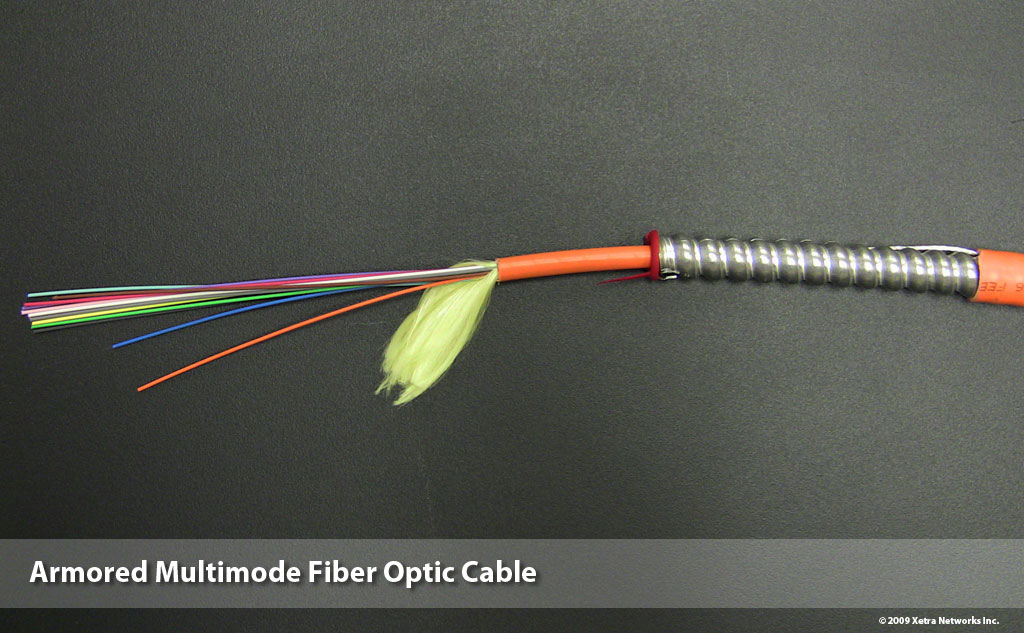Interlock armored fiber optic cable vs innerduct and traditional fiber cabling
Fiber optic installation.
Installation of a fiber optic cabling system can be a great addition to your network infrastructure. One of the most important things to consider when beginning this task is the method in which to protect the delicate fiber optic cable from potentially harmful environmental variables. Commonly, an innerduct is used to house and protect the cable. The innerduct is a corrugated HDPE tube that surrounds the fiber optic cable, acting as a shield for damage and reinforcing the bend radius of the cable. While this method is extremely effective in the protection of your cable, it is also a more time consuming task. This is because the innerduct must first be installed throughout the facility that the fiber cable will be going into. Once the innerduct is fully installed, it is then time to install the fiber optic cable. The fiber optic cable is pulled through the innerduct, installed and terminated as usual. To sum up this process, you are basically performing two installations: the installation for the fiber optic cable and the installation for the protective innerduct. Although innerduct is a great, reliable investment for cable protection, the above mentioned factors can equate to higher installation costs. Not only do you pay more for the physical innerduct material, the time it takes to install the innerduct also presents additional time and labor costs. Wouldn’t it be easier and less expensive if the fiber optic cable, could be installed with its own built in protective shield? Well the good news is it can be. Armored fiber optic cable is available as an alternative to using an innerduct. With armored fiber, there is no need for multiple construction processes. The armored fiber is made with multiple layers of protection and extra reinforcing in the cable housing to prevent damage. Armored fiber cable offers:
- Elevated allowable pulling tension
- Automatically upheld bend radius
- Physical resistance to crushing and abrasion
Basically, armored fiber cable retains just as much protection reliability as with an innerduct, but for potentially less money and construction time. However, every rose has its thorn, by choosing to use armored fiber you might be saving time and money, but certain sacrifices must be made as well. When you install an innerduct, one of the main benefits is that it is a cabling pathway and can be reused should you need to replace the fiber optic cable or add new fiber capacity . If the innerduct has not reached its fill ratio, the additional space left within the innerduct allows for another cable to be run through the existing innerduct thereby maximizing your investment. Should you need to do the same thing with armored cable, you will incur the cost of having to buy and install new armored cable, which is more expensive than standard fiber optic cable.
Important things to consider
It is important to consider this when making the decision on whether to go with armored fiber cable or innerduct. While both are excellent methods of cable protection, it is essential to analyze your fiber cabling needs for both the present and the future, and make your choice based on what your specific requirements are, making sure to plan for potential changes that may occur involving your fiber optic network infrastructure.
Posted in: Structured Cabling by Structured Voice & Data Cabling on July 14, 2009 | No Comments
Categories
Archives
Tag Cloud
cabling CAT3 CAT5e Cat6 CAT6a CAT7a cctv cabling data cabling demarc fiber optic Keystone Jack MPOE plenum Structured Cabling telecom backboard UTP Video Cabling video surveillance cablingStructured Cabling
A structured cabling system provides a platform upon which an overall information system strategy is built. We design flexible cabling infrastructures.
Video Surveillance
We can design, install, & maintain quality CCTV systems that can help reduce criminal activity and give you peace of mind.
Wireless Networks
In building wireless, host spot WiFi or wireless backhaul, we have the wireless network solution you're
looking for.
Server Rooms
See first-hand how our team of experts is trained to assess the important factors to design a server room perfectly suited to your needs.




